下肢骨折
下肢骨折健康教育

下肢骨折健康教育什么是下肢骨折?下肢骨折是指腿部或脚部骨骼的断裂或折断。
常见的下肢骨折包括股骨、胫骨和踝骨的骨折。
下肢骨折通常是由剧烈的外力造成的,如车祸、跌倒或运动伤害。
骨折可能导致严重的疼痛、肿胀和功能障碍。
下肢骨折的症状和体征下肢骨折的症状和体征包括:1. 疼痛和肿胀:由于骨折引起的组织损伤,患者常常会感到剧烈的疼痛,并且出现局部肿胀和淤血。
2. 畸形:骨折部位可能出现明显的畸形,如肢体弯曲或错位。
3. 呼吸困难:当股骨骨折扩展到骨盆区域时,可能造成骨碎片压迫腹腔器官,导致呼吸困难。
4. 失血和休克:严重的骨折可能伴随出血,导致患者出现失血和休克的症状。
下肢骨折的处理和康复下肢骨折需要进行及时处理和适当康复,以促进骨骼的愈合和恢复功能。
处理和康复的步骤包括:1. 急救措施:对于严重的骨折,需要进行急救措施,如止血、固定骨折部位、及时送医。
2. 治疗方法:根据骨折的程度和类型,医生可能选择进行手术治疗或保守治疗。
手术治疗包括骨折复位和内固定,保守治疗包括石膏固定和功能锻炼。
3. 康复锻炼:在骨折愈合后,康复锻炼是恢复下肢功能的关键。
康复锻炼应根据患者的具体情况进行,包括肌肉力量练习、平衡训练和步态训练等。
4. 饮食调理:在康复期间,患者应保持均衡的饮食,摄入足够的营养物质,如蛋白质、维生素和矿物质,以促进骨折的愈合和身体的恢复。
5. 心理支持:骨折对患者的身心健康都有一定的负面影响,提供心理支持和鼓励是康复过程中不可或缺的一环。
预防下肢骨折的措施预防下肢骨折的措施涉及以下方面:1. 减少跌倒风险:保持家居环境的整洁和安全,使用防滑材料,保证室内外的光线充足,尽量避免走在不平整或湿滑的地面。
2. 运动安全:在进行高风险运动或活动时,如滑雪、登山等,应保证个人技能和装备的安全,严格遵守相关规则和要求。
3. 身体平衡锻炼:通过均衡的饮食、适量的锻炼和维持正常体重,可以增强肌肉力量和平衡能力,有助于预防骨折。
下肢骨折课件

02
症状:疼痛、肿胀、畸 形、功能障碍等
2P1
STEP2
STEP3
STEP4
病史询问:了解 患者受伤情况、 疼痛部位、持续 时间等
体格检查:观察 患者下肢肿胀、 畸形、活动受限 等情况
影像学检查:X光 片、CT、MRI等, 了解骨折类型、 骨折线位置、骨 折端移位情况等
02
遵守交通规则, 避免交通事故
03
加强体育锻炼, 增强身体素质
04
定期进行健康 检查,及时发 现和预防疾病
4
下肢骨折的案例 分析
典型案例
案例一:患者A,男性,45岁,因
A
车祸导致下肢骨折,经过手术治疗
和康复训练后,恢复良好。
案例二:患者B,女性,28岁,因
B
运动损伤导致下肢骨折,经过手术
治疗和康复训练后,恢复良好。
法,降低骨折风险
康复治疗
康复目标: 恢复下肢功 能,提高生
活质量
康复方法: 物理治疗、 运动疗法、 作业疗法等
康复过程: 早期康复、 中期康复、
后期康复
康复注意事 项:遵医嘱, 避免过度运 动,注意饮
食营养等
3 下肢骨折的预防
预防措施
01 加强体育锻炼,增强 骨骼强度
02 避免过度劳累,保持 良好的作息习惯
形骨折、螺旋形骨折等。
下肢骨折的常见类型
股骨颈骨折:股骨颈 骨折是最常见的下肢 骨折类型,通常由跌 倒、车祸等外伤引起。
胫骨平台骨折:胫骨平 台骨折是指胫骨近端
(胫骨近端)的骨折, 通常由跌倒、车祸等外
伤引起。
股骨粗隆间骨折:股骨 粗隆间骨折是指股骨粗 隆部(股骨近端)的骨 折,通常由跌倒、车祸
下肢骨折 伤残等级
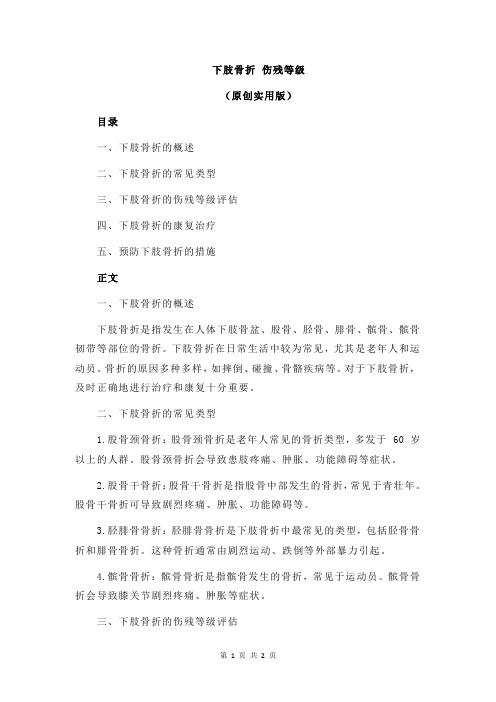
下肢骨折伤残等级(原创实用版)目录一、下肢骨折的概述二、下肢骨折的常见类型三、下肢骨折的伤残等级评估四、下肢骨折的康复治疗五、预防下肢骨折的措施正文一、下肢骨折的概述下肢骨折是指发生在人体下肢骨盆、股骨、胫骨、腓骨、髌骨、髌骨韧带等部位的骨折。
下肢骨折在日常生活中较为常见,尤其是老年人和运动员。
骨折的原因多种多样,如摔倒、碰撞、骨骼疾病等。
对于下肢骨折,及时正确地进行治疗和康复十分重要。
二、下肢骨折的常见类型1.股骨颈骨折:股骨颈骨折是老年人常见的骨折类型,多发于 60 岁以上的人群。
股骨颈骨折会导致患肢疼痛、肿胀、功能障碍等症状。
2.股骨干骨折:股骨干骨折是指股骨中部发生的骨折,常见于青壮年。
股骨干骨折可导致剧烈疼痛、肿胀、功能障碍等。
3.胫腓骨骨折:胫腓骨骨折是下肢骨折中最常见的类型,包括胫骨骨折和腓骨骨折。
这种骨折通常由剧烈运动、跌倒等外部暴力引起。
4.髌骨骨折:髌骨骨折是指髌骨发生的骨折,常见于运动员。
髌骨骨折会导致膝关节剧烈疼痛、肿胀等症状。
三、下肢骨折的伤残等级评估下肢骨折的伤残等级评估主要依据骨折部位、骨折类型、治疗情况等因素进行。
根据我国《劳动能力鉴定标准》,下肢骨折的伤残等级分为十个等级,从一级(完全丧失劳动能力)到十级(基本无影响)。
四、下肢骨折的康复治疗1.早期康复:主要是指骨折后 1-2 周内的康复治疗。
此阶段主要目标是减轻疼痛、消肿、防止肌肉萎缩和关节僵硬。
患者需要进行适量的肌肉锻炼和关节活动。
2.中期康复:是指骨折后 2-6 周的康复治疗。
此阶段的目标是恢复关节活动度和肌肉力量。
患者需要进行渐进式的肌肉锻炼和关节活动。
3.后期康复:是指骨折后 6 周至半年的康复治疗。
此阶段的目标是恢复日常生活能力。
患者需要进行生活技能训练和功能锻炼。
五、预防下肢骨折的措施1.加强锻炼:适当的锻炼可以增强骨骼和肌肉的力量,提高关节的稳定性,降低骨折的风险。
2.注意安全:在日常生活中,要注意避免摔倒、碰撞等可能导致骨折的危险因素。
下肢骨折康复评定内容
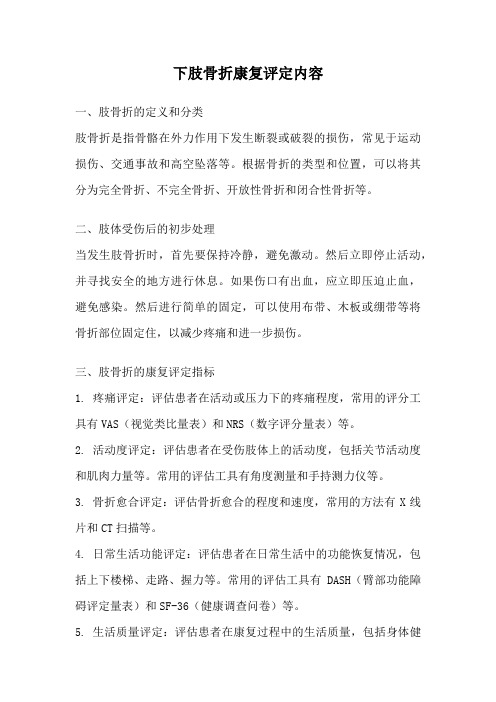
下肢骨折康复评定内容一、肢骨折的定义和分类肢骨折是指骨骼在外力作用下发生断裂或破裂的损伤,常见于运动损伤、交通事故和高空坠落等。
根据骨折的类型和位置,可以将其分为完全骨折、不完全骨折、开放性骨折和闭合性骨折等。
二、肢体受伤后的初步处理当发生肢骨折时,首先要保持冷静,避免激动。
然后立即停止活动,并寻找安全的地方进行休息。
如果伤口有出血,应立即压迫止血,避免感染。
然后进行简单的固定,可以使用布带、木板或绷带等将骨折部位固定住,以减少疼痛和进一步损伤。
三、肢骨折的康复评定指标1. 疼痛评定:评估患者在活动或压力下的疼痛程度,常用的评分工具有VAS(视觉类比量表)和NRS(数字评分量表)等。
2. 活动度评定:评估患者在受伤肢体上的活动度,包括关节活动度和肌肉力量等。
常用的评估工具有角度测量和手持测力仪等。
3. 骨折愈合评定:评估骨折愈合的程度和速度,常用的方法有X线片和CT扫描等。
4. 日常生活功能评定:评估患者在日常生活中的功能恢复情况,包括上下楼梯、走路、握力等。
常用的评估工具有DASH(臂部功能障碍评定量表)和SF-36(健康调查问卷)等。
5. 生活质量评定:评估患者在康复过程中的生活质量,包括身体健康、心理健康和社交功能等。
常用的评估工具有EQ-5D(健康状态评定量表)和WHOQOL(世界卫生组织生活质量问卷)等。
四、肢骨折康复的注意事项1. 合理的饮食:骨折康复期间,患者需要注意补充足够的蛋白质、维生素和矿物质等营养物质,以促进骨折愈合和肌肉恢复。
2. 正确的固定和活动:在康复期间,患者需要遵循医生的指导,正确固定骨折部位,并进行适当的活动,以避免关节僵硬和肌肉萎缩。
3. 定期复查:患者在康复期间需要定期复查,以评估骨折愈合的情况,并及时调整康复方案。
4. 心理支持:康复期间,患者可能会面临着疼痛、焦虑和抑郁等心理问题,需要得到家人和医护人员的支持和关心。
5. 避免再次受伤:康复期间,患者需要避免剧烈运动和高风险活动,以免再次受伤延迟康复进程。
下肢骨折健康教育

下肢骨折健康教育下肢骨折健康教育1. 什么是下肢骨折?下肢骨折是指腰部以下的骨骼发生断裂或破损的情况。
下肢包括髋关节、股骨、胫骨和腓骨等骨骼。
下肢骨折往往由于剧烈的外力作用造成,如跌倒、交通事故、运动损伤等。
下肢骨折会导致患者的日常生活受限,对人体行走和活动功能造成重大影响。
2. 下肢骨折的分类根据骨折的位置和骨折线的形态,下肢骨折可以分为多种类型,常见的包括:- 髋关节骨折:指髋臼或股骨头的骨折。
- 股骨骨折:股骨是连接髋关节和膝关节的长骨,股骨骨折可以发生在颈部、干骺部或骨折端。
- 胫骨骨折:胫骨是前下肢的长骨,骨折可发生在胫骨干骺端或骨折端。
- 腓骨骨折:腓骨是胫骨的辅助骨,常与胫骨同时骨折。
3. 下肢骨折的原因下肢骨折的主要原因是外力作用,常见的原因包括:- 意外跌伤:在日常生活中意外摔倒或从高处跌落。
- 交通事故:包括车祸和行人被撞等。
- 运动损伤:运动中受到的冲击力或扭曲力造成的骨骼损伤。
- 骨质疏松:骨质疏松使骨骼易于发生骨折。
4. 下肢骨折的症状和诊断方法下肢骨折的常见症状包括剧烈疼痛、肿胀、变形、不能负重以及无法正常行走等。
如果怀疑下肢骨折,应该及时就医,医生会采用以下方法进行诊断:- 体格检查:医生会仔细观察患者下肢的外观,包括皮肤状态、肿胀和变形等。
- X光检查:X光可以清晰显示骨折的位置、类型和程度。
- CT扫描:CT扫描可以提供更详细的骨折影像,帮助医生做出更准确的诊断。
5. 下肢骨折的治疗方法下肢骨折的治疗方法取决于骨折的类型和程度。
常用的治疗方法包括:- 保守治疗:适用于稳定性好的骨折,通常采用石膏固定和休息,帮助骨折愈合。
- 手术治疗:适用于不稳定性高的骨折,如关节骨折或复合骨折等。
手术可以通过内固定物(如钢板和螺钉)将骨骼固定在正确的位置。
- 康复治疗:骨折愈合后,患者需要进行康复训练,包括物理治疗和功能锻炼等,帮助恢复下肢的功能和活动能力。
6. 下肢骨折的康复护理下肢骨折康复护理十分重要,以下是一些常用的康复护理方法:- 药物治疗:根据医嘱服用消炎药、止痛药和钙剂等药物,有助于减轻疼痛和促进骨折愈合。
下肢骨折急救措施

下肢骨折急救措施下肢骨折急救措施骨折是指骨头的断裂,下肢骨折是指在膝盖以下的腿部骨头断裂。
下肢骨折急救措施的正确实施可以有效地减轻疼痛,防止出血和其他并发症的出现。
下面将详细介绍下肢骨折急救措施。
一、判断是否为骨折当遇到下肢受伤时,首先要判断是否为骨折。
常见的症状包括:1. 疼痛:当受伤部位移动或触碰时会感到剧烈的疼痛。
2. 肿胀:受伤部位会出现明显的肿胀。
3. 变形:如果是复杂性骨折,受伤部位可能会出现明显的变形。
4. 不能承重:如果是腿部长骨、脚踝或足部的骨折,患者无法承重行走。
如果以上任意一项被满足,则有可能是下肢骨折,应该立即进行急救处理。
二、停止出血如果下肢骨折伴随着出血,需要立即进行止血。
具体步骤如下:1. 用干净的纱布或毛巾覆盖在伤口上。
2. 用手掌按住伤口,施加适当的压力。
3. 抬高受伤部位,以减少出血量。
4. 如果出血量过多,应该立即拨打急救电话或前往医院就诊。
三、固定受伤部位固定受伤部位是下肢骨折急救中非常重要的一步。
它可以减轻疼痛、防止进一步的损伤和加速愈合。
具体方法如下:1. 先将患者放置在平坦的地面上,并保持安静不动。
2. 用软垫或毛巾垫在患者腿部两侧,并将受伤部位固定在一个位置上。
3. 使用绷带或其他可用材料将受伤部位进行固定,以避免移动和进一步损伤。
4. 如果是膝盖以下的骨折,可以使用三角巾将受伤腿固定在健康腿上。
四、疼痛缓解下肢骨折会伴随着剧烈的疼痛,需要进行相应的缓解。
具体方法如下:1. 给患者口服止痛药,如对乙酰氨基酚等。
2. 用冰袋或冷敷物贴在受伤部位上,以减轻肿胀和疼痛。
3. 让患者保持平静和放松,避免过度紧张和焦虑。
五、送医就诊如果下肢骨折比较严重或出现其他并发症,需要及时送医就诊。
具体情况包括:1. 复杂性骨折:受伤部位出现明显的变形或移位。
2. 骨折伴随着大量出血或神经损伤。
3. 患者无法承重行走或不能正常活动。
4. 骨折后出现感染、发热等不适症状。
下肢骨折护理常规

2.加强体育煅炼,增强体能和身体的协调性,防止骨质疏松,减少骨折。
3.指导患者进行合理有效的、循序渐进的功能锻炼。
4.指导患者定时更换体位,定时排便习惯,预防便秘。
5.去除牵引和外固定后,鼓励患者尽量使用拐杖,防止负重再叠仆。
6.定期到医院复查。
下肢骨折护理常规
指下肢及下肢带骨的骨连续性中断。常见的有股骨颈骨折、股骨粗隆间骨折、股骨干骨折、膑骨骨折、胫腓骨骨折、踝部骨折等。
一、按一般护理常规进行
二、嘱患者保持功能体位或治疗所需体位。
三、观察患者的生命体征、患肢局部疼痛、皮肤颜色、温度等病情变化,发现异常及时报告医师并配合处理,做好护理记录。
四、给药护理
1.疼痛时遵医嘱使用止痛剂或针刺止痛。
2.遵医嘱局部贴敷时,注意避免烫伤皮肤,过敏者及时揭去,并注意观察药后反应。
五、饮食护理:饮食宜清淡,多食新鲜蔬菜、水果,多饮水。
六、临证(症)施护
1.下肢骨折一般应使髋关节屈曲15°、外展20°、膝关节屈曲15°、踝关节背伸90°、足尖向上位。
2.股骨颈骨折、股骨粗隆骨折时,应保持患肢外展中立位,防止外旋、内收。
下肢骨折工伤认定标准
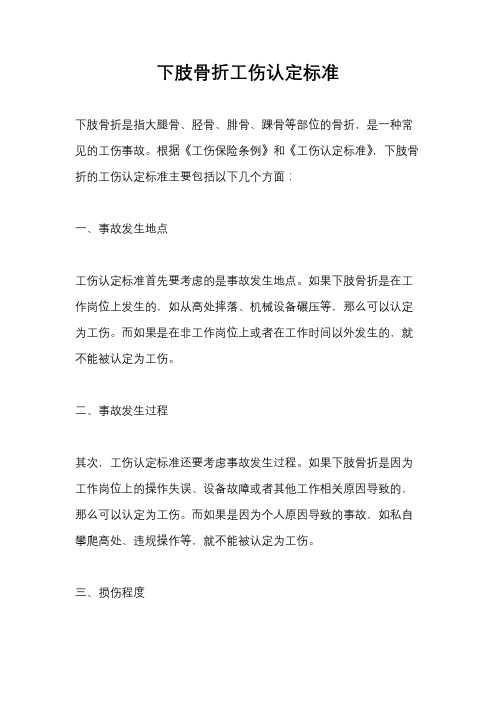
下肢骨折工伤认定标准
下肢骨折是指大腿骨、胫骨、腓骨、踝骨等部位的骨折,是一种常见的工伤事故。
根据《工伤保险条例》和《工伤认定标准》,下肢骨折的工伤认定标准主要包括以下几个方面:
一、事故发生地点
工伤认定标准首先要考虑的是事故发生地点。
如果下肢骨折是在工作岗位上发生的,如从高处摔落、机械设备碾压等,那么可以认定为工伤。
而如果是在非工作岗位上或者在工作时间以外发生的,就不能被认定为工伤。
二、事故发生过程
其次,工伤认定标准还要考虑事故发生过程。
如果下肢骨折是因为工作岗位上的操作失误、设备故障或者其他工作相关原因导致的,那么可以认定为工伤。
而如果是因为个人原因导致的事故,如私自攀爬高处、违规操作等,就不能被认定为工伤。
三、损伤程度
工伤认定标准还需要考虑下肢骨折的损伤程度。
一般来说,如果下
肢骨折需要住院治疗并且影响了工作能力,可以被认定为工伤。
而
如果只是轻微的骨折,不需要住院治疗或者不影响工作能力,就不
能被认定为工伤。
四、医疗证明
最后,工伤认定标准还需要考虑医疗证明。
申请工伤认定的员工需
要提供相关的医疗证明,证明下肢骨折是在工作岗位上发生的,并
且需要住院治疗。
医疗证明的真实性和完整性对工伤认定至关重要。
综上所述,下肢骨折的工伤认定标准主要包括事故发生地点、事故
发生过程、损伤程度和医疗证明这几个方面。
只有符合这些标准,
下肢骨折才能被认定为工伤。
希望雇主和员工都能够加强安全意识,减少工伤事故的发生,共同营造一个安全、健康的工作环境。
骨折-下肢骨折(中医骨伤科学十三五教材)
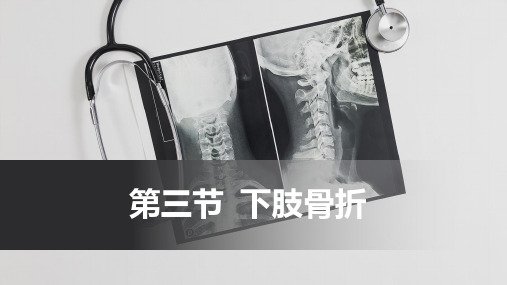
【治疗】
应按照骨折的时间、类型和患者的全身情况等 决定治疗方案。新鲜无移位骨折或嵌插骨折不 需复位,但患肢应制动;移位骨折应尽早给予 复位和固定;陈旧性股骨颈骨折可采用髋关节 重建术或改变下肢负重力线的截骨术,以促进 骨折愈合或改善功能。
1.整复方法
(1)屈髋屈膝法患者仰卧,助手固定骨盆,术者握其 腘窝,并使膝、股均屈曲90°,向上牵引,纠正缩短畸形。 然后内旋外展髋关节并伸直下肢,以纠正成角畸形, 并使折面紧密接触。复位后可做手掌试验,如患肢外 旋畸形消失,表示已复位(图6-69)。
第三节 下肢骨折
下肢的主要功能是负重和行走,故需要良好的 稳定结构,两下肢要等长。当下肢发生骨折后, 对骨折整复要求高,不仅需要患肢与健肢的长 度相等,而且要求对位对线良好。若患肢成角 畸形,将会影响肢体的承重力;若患肢短缩在 2cm以上者,则会出现跛行。
Hale Waihona Puke 下肢肌肉发达,骨折整复后,单纯夹板固 定难以保持断端整复后的位置,尤其是股 骨干骨折及不稳定的胫腓骨骨折,常需配 合持续牵引,固定时间也应相对长些,以 防止过早负重而发生畸形或再骨折。
股骨颈骨折 股骨转子间骨折 股骨干骨折 股骨踝上骨折 股骨髁间骨折 髌骨骨折 胫骨髁骨折 胫腓骨干骨折 踝部骨折 距骨骨折 跟骨骨折 跖骨骨折 趾骨骨折
股骨颈骨折
股骨颈骨折是指股骨头下至股骨颈基底部 的骨折。股骨颈和股骨干之间形成一个角 度称内倾角,又称颈干角,正常值在110°〜 140°之间。颈干角随年龄的增加而减小,儿 童平均为151°,而成人男性为132°,女性为 127°。
基底部骨折因骨折线部分在关节囊外,而且一般移位 不多,除由股骨干髋腔来的滋养血管的血供断绝外, 由关节囊来的血运大多完整无损,骨折近端血液供应 良好,因此骨折不愈合和股骨头缺血性坏死的发生率 较低。
下肢骨折健康教育

下肢骨折健康教育下肢骨折健康教育概述:下肢骨折是指大腿、小腿、脚踝等部位的骨折。
为了帮助患者更好地了解下肢骨折的情况、处理方法以及康复等相关知识,本文档提供了详细的健康教育内容。
第一章:下肢骨折简介⑴下肢骨折定义⑵下肢骨折的常见原因⑶下肢骨折的分类及症状⑷下肢骨折的并发症第二章:预防下肢骨折⑴营养均衡与骨密度⑵安全使用家具及器具⑶运动训练与肌肉力量⑷定期体检与骨密度检测第三章:下肢骨折的紧急处理⑴创伤现场安全⑵控制出血与保护受伤部位⑶如何正确固定伤处⑷不宜做的处理方法第四章:下肢骨折的治疗方法⑴保守治疗与手术治疗⑵各种治疗方法的适应症和优缺点⑶康复训练与康复治疗第五章:下肢骨折的康复护理⑴术后伤口护理⑵病人的日常护理⑶骨折部位功能恢复训练⑷饮食保健与心理护理第六章:佩戴石膏的护理知识⑴石膏固定的注意事项⑵如何保持洁净与干燥⑶石膏固定的常见问题及应对方法⑷石膏拆除后的保养第七章:常见的下肢骨折并发症及处理方法⑴深静脉血栓形成的预防与治疗⑵恶性肿瘤的筛查与治疗⑶神经损伤与康复训练⑷骨折愈合不良的处理第八章:与下肢骨折相关的法律名词及注释⑴遗产⑵法定继承人⑶遗嘱⑷生前赠与附件:⒈下肢骨折常见的X光片图示⒉下肢骨折康复训练视频教程⒊饮食保健手册注释:⒈遗产:指个人在去世时留下的财产和权益。
⒉法定继承人:根据相关法律规定,依法享有继承权的人。
⒊遗嘱:个人以书面形式,针对自己的财产与权益,在法律规定的范围内,作出分配和处理的意愿。
⒋生前赠与:指个人在生前将自己的财产转移给他人。
下肢骨折的观察要点
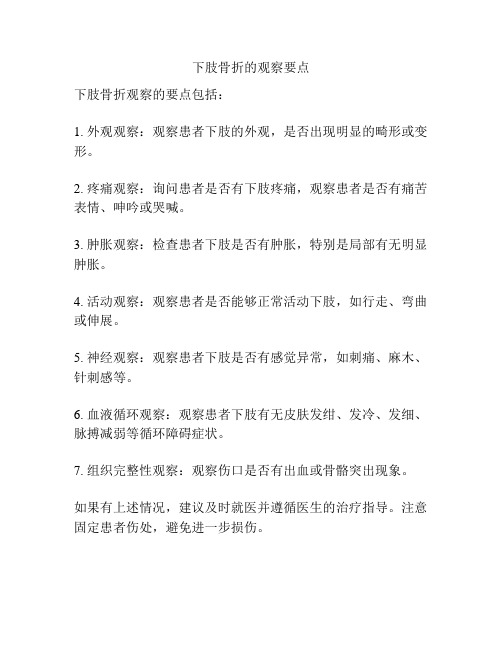
下肢骨折的观察要点
下肢骨折观察的要点包括:
1. 外观观察:观察患者下肢的外观,是否出现明显的畸形或变形。
2. 疼痛观察:询问患者是否有下肢疼痛,观察患者是否有痛苦表情、呻吟或哭喊。
3. 肿胀观察:检查患者下肢是否有肿胀,特别是局部有无明显肿胀。
4. 活动观察:观察患者是否能够正常活动下肢,如行走、弯曲或伸展。
5. 神经观察:观察患者下肢是否有感觉异常,如刺痛、麻木、针刺感等。
6. 血液循环观察:观察患者下肢有无皮肤发绀、发冷、发细、脉搏减弱等循环障碍症状。
7. 组织完整性观察:观察伤口是否有出血或骨骼突出现象。
如果有上述情况,建议及时就医并遵循医生的治疗指导。
注意固定患者伤处,避免进一步损伤。
下肢骨折健康教育简洁范本

下肢骨折健康教育下肢骨折健康教育1. 简介2. 常见类型下肢骨折可分为小腿骨折、踝骨折、髋关节骨折等多种类型。
其中,小腿骨折是最常见的一种。
这些骨折类型通常由外力的直接作用或间接作用导致骨骼发生断裂或折断。
3. 发病原因下肢骨折的发病原因多样化,主要包括以下几点:交通事故:车祸、摩托车事故等会造成下肢骨折,尤其是腿部骨骼容易受到冲击和撞击。
运动损伤:参与高风险和高强度运动(如滑雪、足球、篮球等)会增加下肢骨折的风险。
摔倒受伤:老年人的平衡能力较差,摔倒时易造成下肢骨折。
骨质疏松:骨质疏松可增加骨折的风险,特别是腰椎和髋部骨折。
工伤:从事高空作业或需要长时间站立的工作者,由于工作环境等原因容易发生下肢骨折。
4. 治疗方法下肢骨折的治疗方法主要包括以下几种:保守治疗:适用于稳定性较好的骨折,常采用石膏固定或矫形器固定等方法。
外科手术治疗:适用于复杂性骨折、错位骨折或骨折伴有组织损伤等情况,可以通过内固定、外固定或骨折复位等手术进行治疗。
5. 预防措施下肢骨折的预防措施主要包括以下几个方面:强化锻炼:通过增强下肢肌肉力量和提高骨密度,可以减少骨折的风险。
注意安全:遵守交通规则,避免交通事故;注意家中的排除安全隐患,减少摔倒受伤的可能性。
警惕骨质疏松:合理饮食,摄入足够的钙质和维生素D,保持良好的生活习惯。
使用防护装备:在进行高风险和高强度运动时,佩戴适当的防护装备,减少骨折发生的可能性。
6.下肢骨折是一种常见的骨折类型,它会严重影响患者的生活质量和身体健康。
通过了解下肢骨折的常见类型、发病原因、治疗方法和预防措施,我们可以加强对下肢骨折的认识,提高对其的预防和应对能力,从而降低下肢骨折的风险。
下肢骨折中医护理常规
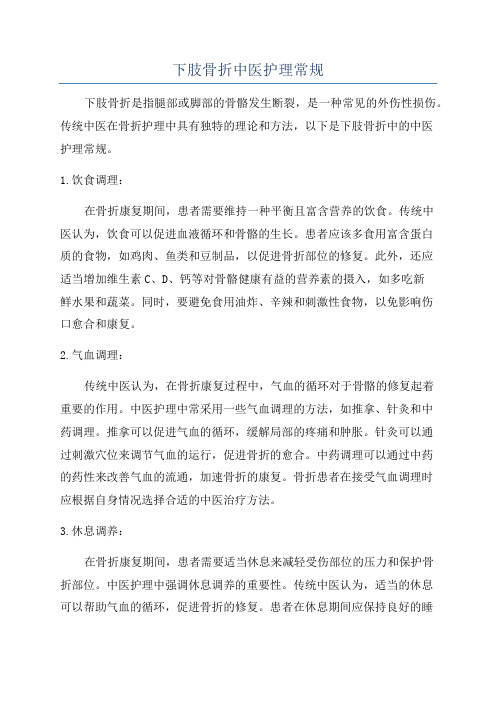
下肢骨折中医护理常规下肢骨折是指腿部或脚部的骨骼发生断裂,是一种常见的外伤性损伤。
传统中医在骨折护理中具有独特的理论和方法,以下是下肢骨折中的中医护理常规。
1.饮食调理:在骨折康复期间,患者需要维持一种平衡且富含营养的饮食。
传统中医认为,饮食可以促进血液循环和骨骼的生长。
患者应该多食用富含蛋白质的食物,如鸡肉、鱼类和豆制品,以促进骨折部位的修复。
此外,还应适当增加维生素C、D、钙等对骨骼健康有益的营养素的摄入,如多吃新鲜水果和蔬菜。
同时,要避免食用油炸、辛辣和刺激性食物,以免影响伤口愈合和康复。
2.气血调理:传统中医认为,在骨折康复过程中,气血的循环对于骨骼的修复起着重要的作用。
中医护理中常采用一些气血调理的方法,如推拿、针灸和中药调理。
推拿可以促进气血的循环,缓解局部的疼痛和肿胀。
针灸可以通过刺激穴位来调节气血的运行,促进骨折的愈合。
中药调理可以通过中药的药性来改善气血的流通,加速骨折的康复。
骨折患者在接受气血调理时应根据自身情况选择合适的中医治疗方法。
3.休息调养:在骨折康复期间,患者需要适当休息来减轻受伤部位的压力和保护骨折部位。
中医护理中强调休息调养的重要性。
传统中医认为,适当的休息可以帮助气血的循环,促进骨折的修复。
患者在休息期间应保持良好的睡眠质量,避免剧烈运动和长时间的站立。
同时,患者应保持良好的心态,积极面对康复过程中可能出现的困难和挫折。
4.外治疗法:中医护理中常采用外治疗法来促进骨折的愈合。
传统中医认为,外治疗法可以通过刺激伤口周围的经络和穴位来促进血液循环和气血的流通。
外治疗法包括热敷、熏洗、药膏外敷等。
热敷可以通过热能来促进伤口周围的血液循环,缓解疼痛和肿胀。
熏洗可以通过中草药的药性来改善伤口的愈合和康复。
药膏外敷可以通过药膏中的药物成分渗入皮肤,促进骨折的愈合。
在使用外治疗法时,应根据患者的具体情况选择合适的方法和药物。
5.心理关怀:在骨折康复过程中,患者需要得到心理方面的关怀和支持。
下肢骨折健康教育简版

下肢骨折健康教育下肢骨折健康教育1. 简介下肢骨折是指大腿骨、胫骨或腓骨等下肢骨骨干发生断裂的损伤。
下肢骨折常见于运动损伤、意外事故或高能量外伤等情况下,对患者的生活和运动功能造成严重影响。
本文将介绍下肢骨折的类型、症状、治疗方式以及预防和康复措施,帮助大家更好地了解和应对下肢骨折。
2. 下肢骨折类型2.1 股骨骨折股骨骨折是最常见的下肢骨折类型之一,特别是在老年人中较为常见。
它可分为粗隆间骨折、远端骨折和骨干骨折等多种类型。
股骨骨折症状包括剧烈疼痛、无法站立和走动、肿胀以及异常形态等。
2.2 胫骨和腓骨骨折胫骨和腓骨骨折常见于高能量外伤或强直性外力作用下,如交通事故或高空坠落。
胫骨骨折的症状包括剧烈疼痛、明显肿胀、脚踝活动受限等。
3. 下肢骨折的治疗下肢骨折的治疗旨在减轻疼痛、恢复骨折的稳定性和促进康复。
- 3.1 保守治疗在某些轻度骨折或老年人中,保守治疗可能是一种选择。
这包括使用石膏或支具固定骨折,以及配合物理疗法、药物治疗和定期随访。
- 3.2 手术治疗对于严重的骨折或需要恢复骨折的稳定性的情况,手术治疗可能是必要的。
手术包括使用钢板、螺钉或外固定器固定骨折,以及修复和重建韧带和软组织。
4. 下肢骨折的预防和康复4.1 预防- 保持良好的身体平衡,避免跌倒和受伤。
- 在进行高风险运动或活动时,戴上适当的保护装备,如护膝和护踝。
- 遵守交通规则和安全措施,降低交通事故发生的风险。
- 保持饮食均衡,增加骨密度。
4.2 康复下肢骨折的康复是恢复骨折部位功能和日常活动能力的过程。
康复措施包括:- 物理疗法:通过运动和热敷等物理手段帮助加速康复。
- 药物治疗:使用适当的药物控制疼痛和促进骨折的愈合。
- 日常生活的逐渐恢复:根据医生或物理治疗师的指导,逐渐恢复日常生活和活动,以避免再次受伤。
5. 结论下肢骨折是一种常见的骨折类型,对患者的生活和运动功能造成严重影响。
及早进行合适的治疗和康复措施,以及采取预防措施,能够帮助患者尽快康复并减少再次受伤的风险。
下肢骨折

骨折辨证
三期辩证
早期
中期 后期
瘀血凝滞
瘀肿渐消 筋骨未坚
活血祛瘀
和营生新 养筋壮骨
新伤续断汤
续筋接骨汤 壮筋养血汤
股骨髁上骨折
腓肠肌止点上2-4cm 松质骨和密质骨移行处
股骨髁上骨折
分型 屈曲型(多见) 伸直型 屈曲型骨折线由后上斜向前下,呈斜形或横 断,受腓肠肌牵拉,向后移位,易压迫损 伤腘动、静脉和神经
下肢骨折 Fractures of the lower extremities
骨折特点
下肢因走路和负重,需要高度的稳定性。 两下肢应等长,若长度相差2厘米以上,就 会影响走路,相差愈大,影响愈严重。因 此,在治疗下肢骨折时应注意以下特点:
下肢骨折特点
一、对复位的要求要高,轴线对位力争接 近正常。因为成角畸形愈大,对关节活动, 承重力线和肢体长度影响愈大。
并发症
3.挤压综合征 肢体肌肉丰厚的部位受压迫 时间过长,解除压迫后,肢体迅速出现以 肿胀、肌红旦白尿,高钾血症为特征的急 性肾功能衰竭。多见于地震、塌方、战伤。
并发症
4.脂肪栓塞综合征 发生在严重创伤,特别是长管骨骨折后, 以进行性低氧血症,皮下、内脏出血、意 识障碍为特征的综合征。发病率1%。 1)、机械学说——游离的脂肪滴进入血 流,阻塞毛细血管 2)、化学学说——应激反应使肺脂酶活 力增高,水解脂肪,聚积于肺
三点负重
三足弓
X线表现
临床表现及诊断
外伤史 症状 体征 X线检查
暴力机制 疼痛、肿胀、功能障碍 局部压痛、纵向叩击痛 足正、斜位片
治疗
跖骨干骨折,多发,无移位保守 有移位骨折宜手术,尤其骨折断端上下重 叠或向足底突起成角者 疲劳骨折 固定保护 第五跖骨基骨折 固定
下肢骨折病人的护理

随访计划与注意事项
随访时间
根据病人的具体情况,制定随访计划,一般建议在出院后1个月、3个月、6个 月和1年进行复查。
注意事项
在随访过程中,应注意观察病人的恢复情况,询问病人的感受和需求,及时调 整治疗方案和护理措施。同时,也要关注病人的心理状态,给予必要的支持和 疏导。
THANKS.
对于软组织损伤和神经血 管损伤的诊断,MRI检查 具有较高的敏感性和特异 性。
实验室检查
血液常规检查
了解病人的红细胞、白细胞和血小板计数,评估是否存在感 染或贫血。
血液生化检查
检测病人的肝肾功能、血糖和电解质等指标,为医生提供病 人全身状况的参考。
康复评估
疼痛评估
评估病人骨折部位的疼痛 程度,为制定康复计划提 供依据。
其他并发症的预防与处理
详细描述
关注肾功能:下肢骨折病人可能 需要使用止痛药等药物治疗,需 关注肾功能状况,及时调整用药 。
总结词:除了深静脉血栓形成和 压疮外,下肢骨折病人还可能面 临其他并发症。
预防肺部感染:鼓励病人进行深 呼吸、咳嗽等肺部功能锻炼,保 持呼吸道通畅。
心理护理:关注病人的心理状态 ,及时进行心理疏导和支持,帮 助病人保持良好的心态。
详细描述
早期活动:鼓励病人尽早进行下肢肌肉 收缩和舒张活动,以促进血液循环。
预防压疮
总结词:长期卧床的病人 容易发生压疮,需要采取 措施预防。
详细描述
定期翻身:每2小时为病 人翻身一次,减轻局部受 压。
增加营养摄入:保证病人 摄入足够的蛋白质和维生 素,增强皮肤抵抗力。
保持皮肤清洁干燥:及时 清理汗液、尿液等,保持 皮肤清洁干燥,避免刺激。
功能评估
下肢骨折定义
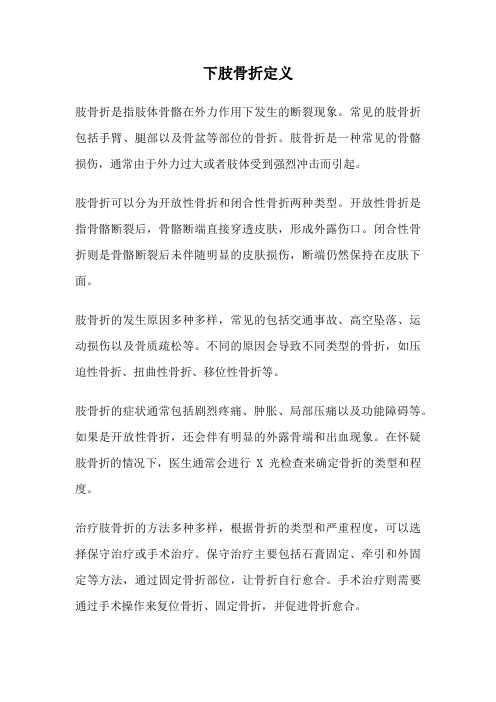
下肢骨折定义肢骨折是指肢体骨骼在外力作用下发生的断裂现象。
常见的肢骨折包括手臂、腿部以及骨盆等部位的骨折。
肢骨折是一种常见的骨骼损伤,通常由于外力过大或者肢体受到强烈冲击而引起。
肢骨折可以分为开放性骨折和闭合性骨折两种类型。
开放性骨折是指骨骼断裂后,骨骼断端直接穿透皮肤,形成外露伤口。
闭合性骨折则是骨骼断裂后未伴随明显的皮肤损伤,断端仍然保持在皮肤下面。
肢骨折的发生原因多种多样,常见的包括交通事故、高空坠落、运动损伤以及骨质疏松等。
不同的原因会导致不同类型的骨折,如压迫性骨折、扭曲性骨折、移位性骨折等。
肢骨折的症状通常包括剧烈疼痛、肿胀、局部压痛以及功能障碍等。
如果是开放性骨折,还会伴有明显的外露骨端和出血现象。
在怀疑肢骨折的情况下,医生通常会进行X光检查来确定骨折的类型和程度。
治疗肢骨折的方法多种多样,根据骨折的类型和严重程度,可以选择保守治疗或手术治疗。
保守治疗主要包括石膏固定、牵引和外固定等方法,通过固定骨折部位,让骨折自行愈合。
手术治疗则需要通过手术操作来复位骨折、固定骨折,并促进骨折愈合。
在骨折愈合的过程中,患者需要注意伤口的护理和功能锻炼。
正确的伤口护理可以预防感染和并发症的发生,而适当的功能锻炼可以促进骨折愈合后的康复恢复。
预防肢骨折的发生,关键在于注意安全。
避免交通事故和高空坠落等危险行为,同时加强骨骼健康的保护,如合理饮食、增加钙摄入、进行适当的运动等。
总结起来,肢骨折是一种常见的骨骼损伤,常见于手臂、腿部等部位。
肢骨折可分为开放性和闭合性两种类型,发生原因多种多样。
治疗方法包括保守治疗和手术治疗,而预防肢骨折的关键在于注意安全和骨骼健康的保护。
- 1、下载文档前请自行甄别文档内容的完整性,平台不提供额外的编辑、内容补充、找答案等附加服务。
- 2、"仅部分预览"的文档,不可在线预览部分如存在完整性等问题,可反馈申请退款(可完整预览的文档不适用该条件!)。
- 3、如文档侵犯您的权益,请联系客服反馈,我们会尽快为您处理(人工客服工作时间:9:00-18:30)。
Classification according to Pauwells’ angle
• Pauwells’ angle >50º is adduction fracture, which is a more vertical and unstable fracture that produces a high risk of union
coxa vara.
The femoral anterersion angle
Epidemiology
1. increased freq with
age dementia malignancy chronic illness, osteoporosis
2. decreased freq with
• Femoral neck factures in young adults are generally associated with highenergy trauma such as motor vehicle accidents
Mechanism of injury
• In general , mechanism of injury is described as a indirect blow, often associated with forced external rotation of the extremity
Methods of treatment
• Internal fixation 1, multiple pins 2, crossed screw-nails 3, compression with dynamic screw and plate • Arthroplasty AMP for pts more than 70 THR for pts less than 70
• Varus displacement of the femoral head
The Garden classification (GradeⅣ)
• Complete loss of continuity between both fragments
Other classification schemes
Shortening Angulation
Rotation
Descriptive animation
Typical displacement realitive to the different location of the fracture
1.proximal 1/3rd fracture 2. Middle 1/3 rd fracture
• Classification according to fracture intra-or extra-capcular
• Classification according to Pauwell’s angle
Neck of Femur fractures
Intracapsular
Extracapsular
Classification
• There are several classification schemes for femoral neck fractures
• The most commonly used classification is that proposed by Garden
The Garden classification (GradeⅠ)
• Valgus impaction of the femoral head
The Garden classification (GradeⅡ)
• Complete but nondisplaced
The Garden classification (GradeⅢ)
Posterior View • Popliteal artery and vein • Sciatic Nerve
Causes
• usually high energy trauma
Classification
• by location, fracture pattern, comminution, soft tissue injury, mechanism
Lower Extremity Fracture
1st hospital of Xinjiang Medical University
Fracture of proximal part of femur
Anatomy review
Blood supply
4 groups 1. Extracapsular arterial ring 2. Ascending cervical branches 3. Subsynovial intracapsular ring ( Chung) 4. Artery of the lig teres
The principles of therapy
• based on pt age and grade of fracture
1. Pt less than 65 and do not have a chronic illness, poor life expectancy ORIF 2. Pt between 65 and 75 those with high functional demand those with low demand , chronic illness arthroplasty 3. Pt more than 75 arthroplasty ORIF
3. Distal 1/3 rd fracture
proximal 1/3rd fracture
M.gluteus medius M.iliopsoas
M. adductor
Middle 1/3 rd fracture
M.iliopsoas M.gluteus medius
M. adductor
multiple pins
Dynamic screw and plate
Complications
1. AVN(avascular necrosis) • undisplaced fracture ~ 10%
displaced fracture up to ~ 80% either partial or complete (variable reporting)
• late segmental collapse occurs in
~ 10% undisplaced fracture ~ 30% displaced fracture
2. Failure of fixation • Nonunion
rare in undisplaced fracture ~ 30% in displaced fracture treat with either a valgus osteotomy or an arthroplasty
Coronal Section
Bony structure
AP Hip Lateral Hip
The neck shaft angle
When it is >127º ,
collum valgum .
The normal neck shaft angle is 127º .
When it is <127º ,
The Garden classification
• This classification is based on the degree of displacement shown on the anteroposterior (AP)radiograph • The Garden classification is of prognostic value for the incidence of avascular necrosis, the higher the Garden number, the higher the incidence
• DVT/PE (deep vein thrombosis)
DVT ~ 40% low dose warfarin in pts who justify risk of anticoagulation
Nonunion
Fracture of Femoral shaft
Anatomy review
• Shorting and external rotation of the leg, usually external rotation degree 40°~60°
The typical deformity
Diagnosis
• History
• Physical examination • Radiographs
Undisplaced
Displaced
Trochanteric
Subtrochantle
Transtrochanteric
Classification according to fracture line
Intra
Intra-capsular
Extra-capsular
long term physical activity supplemental Vit D3 and Cain elderly women HRT
Causes
• The majority of femoral neck fractures are the result of lowenergy trauma such as a simple fall in the elder population
Distal 1/3 rd fracture
